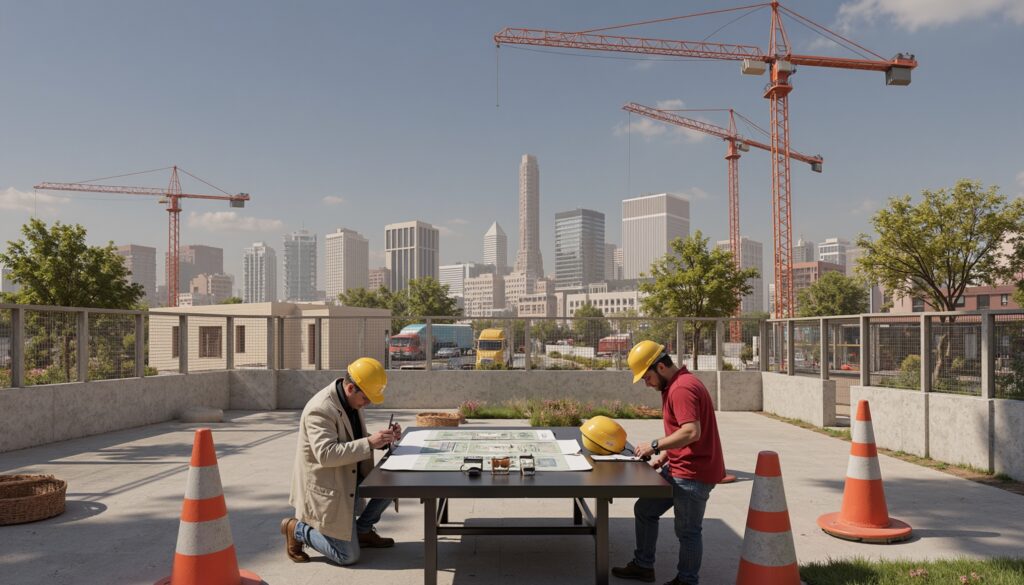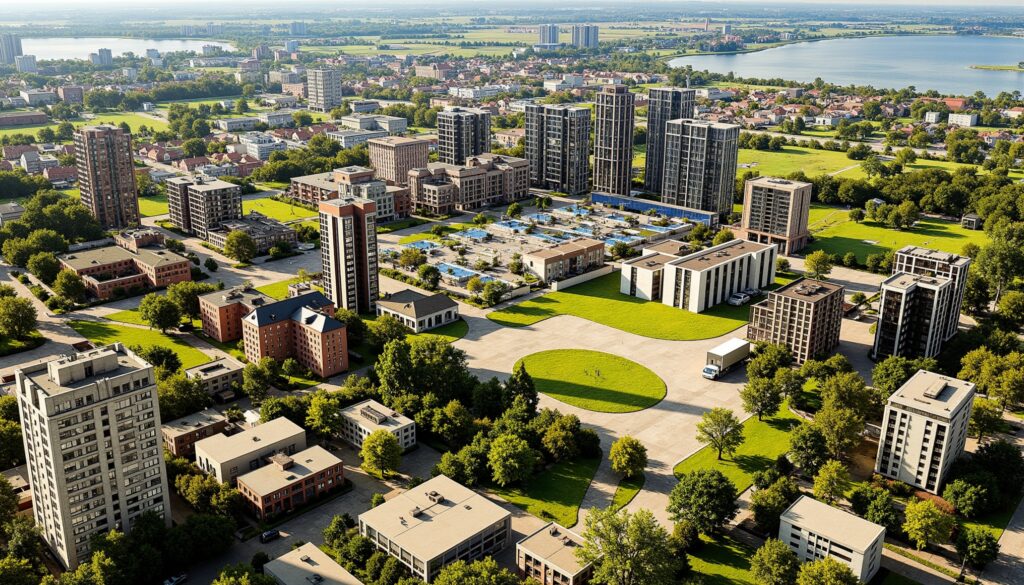Developing a project can be an exciting journey, but often it is riddled with challenges, particularly when it comes to development restrictions.
These limitations can stem from zoning laws, environmental regulations, or community interests, and understanding them is crucial for any developer or investor.
This article will delve into the world of development restrictions, exploring their various types, researching local regulations, and providing practical strategies for navigating the approval process.
Additionally, we will share case studies of successful projects that have managed to overcome these barriers, ensuring that you are well-equipped to tackle any development challenge head-on.

Key Takeaways
- Development restrictions are crucial to consider early in any project planning.
- Understanding local zoning laws can significantly impact the success of a development project.
- Compliance with regulations is essential for navigating the approval process seamlessly.
- Implementing strategic approaches can help mitigate development restrictions effectively.
- Real-world case studies provide valuable insights into overcoming common development barriers.
Understanding Development Restrictions: An Overview
When exploring the dynamic landscape of Costa Rica real estate, understanding development restrictions is crucial for investors, homeowners, and expatriates alike.
Development restrictions in Costa Rica are established to protect natural resources, promote sustainable growth, and preserve the unique ecological balance of this biodiverse country.
These restrictions may pertain to zoning laws, environmental impact assessments, and building permits, all of which can significantly influence property development and renovation projects.
For instance, areas near national parks or protected wildlife zones may have stricter regulations, limiting construction heights and materials used to ensure that local ecosystems are not disrupted.
Additionally, coastal properties must adhere to specific maritime zone laws that dictate how close a structure can be built to the beach.
Awareness of these development restrictions not only helps in aligning property purchases with local laws but also aids in making informed decisions about future renovations or investment potential.
Whether you’re interested in a beachfront villa or a mountain retreat, navigating these regulations carefully can enhance your investment in Costa Rica real estate.
Types of Development Restrictions and Their Implications
When considering investing in Costa Rica real estate, it is crucial to understand the various types of development restrictions that may apply to your property.
These restrictions can significantly influence your investment choices and the potential for property appreciation.
Generally, development restrictions in Costa Rica may stem from zoning laws, environmental regulations, and local ordinances designed to protect the natural beauty and ecological integrity of the region.
For instance, properties located near beaches or protected national parks are subject to stricter building codes to ensure that any developments adhere to sustainable practices and do not harm the environment.
Additionally, certain areas may have limitations regarding the height and density of buildings, aiming to preserve scenic views and maintain the local character.
Understanding these development restrictions not only helps potential buyers navigate the often complex legislative landscape but also ensures that investments align with the long-term vision for sustainable development in Costa Rica.
Engaging with local real estate experts can provide invaluable insights into how these restrictions might affect your specific investment plan.
‘The key to successful project management is not just managing the project but managing the restrictions and constraints that come along with it.’ – Unknown

Researching Local Zoning Laws and Regulations
When considering an investment in Costa Rica real estate, one of the most critical steps is researching local zoning laws and regulations.
Understanding the development restrictions in various areas can play a significant role in your property investment’s success.
Each municipality in Costa Rica has its own set of zoning laws that dictate what types of construction are allowed, the density of buildings, and land usage.
For instance, a beachfront property might be subject to stricter development restrictions aimed at preserving the natural landscape and protecting coastal ecosystems.
Engaging with local real estate experts or legal advisors familiar with Costa Rican regulations can provide invaluable insights, helping you navigate these complexities.
Not only does this diligence safeguard your investment, but it also ensures compliance with local authorities, preventing potential legal issues down the road.
Therefore, as you dive into the world of Costa Rica real estate, prioritizing a thorough understanding of development restrictions is essential for making informed decisions.
Tips for Compliance: Navigating the Approval Process
When delving into the world of Costa Rica real estate, one crucial aspect aspiring buyers and developers must navigate is the approval process, particularly concerning development restrictions.
Understanding these regulations is key to ensuring your project moves forward smoothly.
Here are some essential tips for compliance that can help you successfully navigate this complex landscape.
First, familiarize yourself with the local municipal regulations, as they outline specific development restrictions based on the property’s location.
Each region in Costa Rica may have different zoning laws, environmentally protected areas, and land use designations that could affect your project.
Additionally, consider consulting with a local real estate attorney who specializes in Costa Rican law to help interpret these regulations and prevent costly mistakes.
Lastly, engaging with local communities and understanding their concerns can also ease the approval process, as community support can significantly influence decision-makers.
By prioritizing compliance and leveraging the right resources, you can turn your investment in Costa Rica real estate into a successful venture.

Strategies for Mitigating Development Restrictions
When navigating the complexities of real estate in Costa Rica, one crucial aspect to consider is the impact of development restrictions on your investment opportunities.
These restrictions can arise from environmental regulations, zoning laws, and land use policies designed to protect the country’s rich biodiversity and ecosystems.
To mitigate the impact of development restrictions, potential buyers and investors should adopt several key strategies.
First, conducting thorough due diligence is essential; this includes researching local zoning laws and engaging with experienced real estate agents familiar with the region’s regulatory landscape.
Additionally, consulting with local environmental experts can provide insights into areas where development may be feasible.
Emphasizing sustainable building practices can also help align your projects with government policies aimed at conservation, potentially easing approval processes.
Lastly, building relationships with local authorities can facilitate smoother interactions when navigating the permitting process.
By being proactive and informed about development restrictions, investors can make more strategic decisions in the Costa Rica real estate market.
Case Studies: Successful Projects That Overcame Development Barriers
In the realm of Costa Rica real estate, navigating development restrictions can often pose significant challenges for investors and developers alike.
However, a closer look at successful projects unveils how innovative strategies can overcome these barriers.
One such case is the Pacifico Development in Guanacaste, which expertly tackled local zoning laws by engaging with community leaders and showcasing the environmental sustainability of their plans.
By prioritizing eco-friendly features and garnering local support, they not only complied with development restrictions but also enhanced the value of their properties.
Similarly, the launch of Las Catalinas demonstrated how adaptive reuse of land can align with governmental regulations.
Developers transformed a previously restricted area into a vibrant, walkable community that respects the local ecology while driving tourism and real estate sales.
These case studies exemplify that with strategic planning and community engagement, the complexities of development restrictions in Costa Rica can be transformed into opportunities for thriving real estate ventures.
Frequently Asked Questions
What are development restrictions?
Development restrictions are regulations and limitations imposed by local governments or zoning authorities that dictate how land can be used or developed.
These can include zoning laws, environmental regulations, and historic preservation rules.
How can I find out about the development restrictions in my area?
You can research local zoning laws and regulations through your city or county planning department’s website, or by consulting with a local zoning board or real estate attorney who specializes in land use.
What are the different types of development restrictions?
Development restrictions can include zoning codes, building height limits, setback requirements, land use regulations, environmental protection laws, and historic district designations, each with its own set of implications for development.
What strategies can I use to navigate the approval process for a development project?
To successfully navigate the approval process, engage with local officials early, prepare comprehensive and compliant project plans, gather community support, and consider consulting with professionals familiar with the local approval landscape.
Can you provide an example of a successful project that overcame development restrictions?
Yes, one example is a mixed-use development that initially faced height restrictions but utilized community engagement to demonstrate benefits, ultimately receiving approval through a variance that allowed for a taller structure in exchange for added public amenities.





